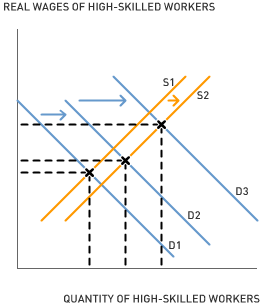The Income Gap and Education
by Brandon Fuller The gap between the incomes of the richest and poorest Americans has been widening since the 1970s. According to a recent New York Times column by Tyler Cowen, the widening gap reflects the difference in earnings growth between high-skilled and low-skilled workers—the earnings of high-school graduates grew more slowly than those of college graduates. A recent paper by Harvard economists Claudia Goldin and Lawrence Katz suggests that immigration accounts for only a small part of the relatively slow earnings growth among high-school graduates.
The gap between the incomes of the richest and poorest Americans has been widening since the 1970s. According to a recent New York Times column by Tyler Cowen, the widening gap reflects the difference in earnings growth between high-skilled and low-skilled workers—the earnings of high-school graduates grew more slowly than those of college graduates. A recent paper by Harvard economists Claudia Goldin and Lawrence Katz suggests that immigration accounts for only a small part of the relatively slow earnings growth among high-school graduates.According to Goldin and Katz, developments in the market for high-skilled labor better explain the growing income gap than developments (such as illegal immigration) in the market for low-skilled labor. Technological improvement typically leads to rising demand for the high-skilled workers capable of using the new technology. Over the past few decades, technological change has increased demand for highly skilled workers, but the supply of such workers has remained stagnant. Strong demand growth coupled with weak supply growth has led to unusually high wage gains for high-skilled workers (as illustrated in the graph above). Read Cowen's column to learn more.
Discussion Questions
1. According to Cowen, how does the educational attainment of the current generation compare to that of their parents?
2. Why has the supply of high-skilled labor increased so slowly? What policies does Katz recommend to remove the bottlenecks that keep Americans from obtaining more education?
3. Will a more educated population guarantee a decrease the income gap between the richest and poorest Americans? What is the rather unpredictable role of technological change in determining the size of the income gap?
Economist Joel Waldfogel's latest Slate piece focuses on an alternative approach to promoting educational attainment among low-income groups. Recent research by Nobel-winning economist James Heckman and University of Michigan economist Dimitriy Masterov suggests that government spending on preschool education offers bigger returns than spending on other parts of the education spectrum (like GED programs or efforts to reduce high-school class sizes). Compared to disadvantaged kids without preschool exposure, disadvantaged kids who received preschool education tended to perform better later in life—higher grades, more likely to graduate, more likely to be employed, less likely to commit crime, and less likely to be on public assistance. Read Waldfogel's column to find out more.
4. Could diverting education spending to intensive preschool programs reduce the income gap between rich and poor Americans? How do differences in cognitive development at kindergarten age feed into differences in earnings potential later in life?
5. Positive externalities occur when we do things that are good for us, but also inadvertently good for others. Preschool provides private benefits directly to families and kids, but it also provides social benefits to the rest of us—social benefits that the parents of young children do not account for when deciding whether to pay for preschool education. What are the social benefits of preschool? Why might government intervention lead to a more efficient preschool outcome?
Here's another Aplia perspective on the disparate wages of low-skilled and high-skilled workers.
Labels: Education, Externalities, Income Inequality



